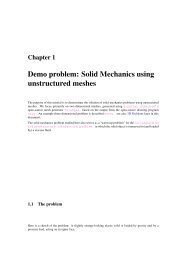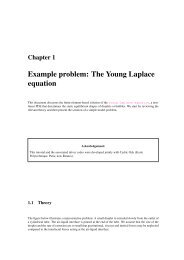Demo problem: Turek & Hron's FSI benchmark problem - Oomph-lib
Demo problem: Turek & Hron's FSI benchmark problem - Oomph-lib
Demo problem: Turek & Hron's FSI benchmark problem - Oomph-lib
Create successful ePaper yourself
Turn your PDF publications into a flip-book with our unique Google optimized e-Paper software.
2 <strong>Demo</strong> <strong>problem</strong>: <strong>Turek</strong> & Hron’s <strong>FSI</strong> <strong>benchmark</strong> <strong>problem</strong><br />
traction-free. We model the flag as a linearly elastic Hookean solid with elastic modulus E ∗ , density ρ s<br />
and Poisson’s ratio ν.<br />
Figure 1.1: Sketch of the <strong>problem</strong> in dimensional variables.<br />
We non-dimensionalise all length and coordinates on the diameter of the cylinder, d ∗ , the velocities on<br />
the mean velocity, U ∗ , and the fluid pressure on the viscous scale. To faciliate comparisons with <strong>Turek</strong><br />
& Hron’s dimensional <strong>benchmark</strong> data (particularly for the period of the self-excited oscillations), we<br />
use a timescale of T ∗ = 1 sec to non-dimensionalise time. The fluid flow is then governed by the nondimensional<br />
Navier-Stokes equations<br />
(<br />
Re St ∂u )<br />
i<br />
∂t + u ∂u i<br />
j = − ∂p +<br />
∂ [( ∂ui<br />
+ ∂u )]<br />
j<br />
,<br />
∂x j ∂x i ∂x j ∂x j ∂x i<br />
where Re = ρU ∗ H ∗ 0 /µ and St = d ∗ /(U ∗ T ∗ ), and<br />
subject to parabolic inflow<br />
∂u i<br />
∂x i<br />
= 0,<br />
u = 6x 2 (1 − x 2 )e 1<br />
at the inflow cross-section; parallel, axially-traction-free outflow at the outlet; and no-slip on the stationary<br />
channel walls and the surface of the cylinder, u = 0. The no-slip condition on the moving flag is<br />
u = St ∂R w(ξ [top,tip,bottom] , t)<br />
∂t<br />
(1)<br />
where ξ [top,tip,bottom] are Lagrangian coordinates parametrising the three faces of the flag.<br />
We describe the deformation of the elastic flag by the non-dimensional position vector R(ξ 1 , ξ 2 , t) which<br />
is determined by the principle of virtual displacements<br />
∫ { ( ) } ∮<br />
σ ij δγ ij − f − Λ 2 ∂2 R<br />
∂t 2 · δR dv − t · δR dA = 0, (2)<br />
A tract<br />
v<br />
where all solid stresses and tractions have been non-dimensionalised on Young’s modulus, E ∗ ; see the<br />
Solid Mechanics Tutorial for details. The solid mechanics timescale ratio (the ratio of the<br />
Generated on Mon Aug 10 11:44:25 2009 by Doxygen






